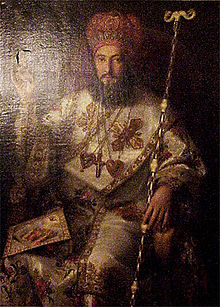- Maximos III Mazloum
-
Maximos III Mazloum Patriarch of Antioch 
Church Melkite Greek Catholic Church See Antioch Enthroned March 24, 1833 Reign ended August, 1855 Predecessor Ignatius V Qattan Successor Clement Bahouth Orders Ordination 1806 (Priest) Consecration August 5, 1810 (Bishop)
by Agapius II MatarPersonal details Birth name Michael Mazloum Born November, 1779
Aleppo, SyriaDied August, 1855 Maximos III Michael Mazloum, (1779 – 1855) was patriarch of the Melkite Greek Catholic Church from 1833 until 1855. As patriarch he reformed church administration and bolstered clerical education. He was also the first Melkite patriarch granted civil authority by the Ottoman empire when the Melkites were recognized as a unique millet.
Contents
Life
Born in Aleppo, Syria in November 1779, Mazloum was ordained priest in 1806. Mazloum was a protege of Germanos Adam, the Melkite Archbishop of Aleppo. Adam, a theologian, was wary of the Latinizing influence of Western missionaries and championed the rights of the Melkite Church but also was taken by the Jansenist ideas of Scipione de' Ricci[1] and not liked by the Latin missionaries of Aleppo because of litigations on properties. As a consequence, in June 1810 Rome opposed the elevation of Mazloum as Adam's successor in Aleppo. But Michael Mazloum was elected bishop of Aleppo on 26 July 1810 and consecrated bishop on August 5, 1810 by patriarch Agapius II Matar, taking the name of Maximos.[2]
His appointment as bishop of Aleppo was contested by Propaganda Fide (and by Ignatius IV Sarrouf, Archbishop of Beirut and future patriarch). On May 1811 a compromise was reached: Mazloum was offered the position of superior of the first Melkite seminary established in Ain Traz. In 1814 Mazloum was sent to Rome by the Melkite Episcopal Synod to appeal his dismissal from the See of Aleppo: Pope Pius VII on July 24, 1814 rejected the appeal and asked Mazloum (who was given the titular title of Myra) to remain in Europe.[3] Mazloum remained in Europe until 1831, living mainly in Rome, and endearing himself to the Roman Curia because of his untiring efforts in aid of the Melkites.
From 1817 to 1823 Mazloum traveled in France and in Vienna. In 1819 he petitioned the Catholic authorities to lean on the Ottoman Empire to stop the persecutions of the Greek Orthodox Church of Antioch against the Catholic Melkites.[3] He spent time translating spiritual and theological books, and in 1821 founded the Greek Catholic parish of St. Nicholas in Marseille, France for Melkites.[4] He returned to the East in 1831.
On March 24, 1833 he was appointed patriarch of the Melkites. In 1834 he entered in Damascus, whence his predecessor Cyril VI Tanas had to escape because of religious persecutions. On 31 October 1837 he was recognized by the Ottoman Empire as the civil authority of a millet, a distinctive religious community within the Empire, thus obtaining civic emancipation for his Church. In 1838 Pope Gregory XVI granted him the titles of Patriarch of Alexandria and Jerusalem, and from then on the title held by the leader of the Melkite Church is Patriarch of Antioch and All the East, of Alexandria and Jerusalem of the Melkite Greek Catholic Church.
His action as patriarch was strong (he was named "untiring fighter"): he carried on a legislative reform of Church (synods of 1835 and 1849) and reformed the religious instruction, giving also new life to the patriarchal Ain Traz Seminary.
During a visit in Paris in 1841 with the purpose to seek support for the Melkite Church, he adopted for himself and for his successors the office of Spiritual Protector of the Order of Saint Lazarus that operated in Palestine. From that time to 1910 the Melkite patriarchs administrated such an order.
As patriarch he resided in Beirut until his death in 1855.
See also
Notes
References
- "Archbishop Maximos III Michel Mazloum". Catholic-Hierarchy.org. http://www.catholic-hierarchy.org/bishop/bmazl.html. Retrieved 2009-01-11.
- Descy, Serge (1993). The Melkite Church. Boston: Sophia Press.
- Dick, Ignatios (2004). Melkites: Greek Orthodox and Greek Catholics of the Patriarchates of Antioch, Alexandria and Jerusalem. Boston: Sophia Press.
- Frazee, Charles A. (2006). Catholics and Sultans: The Church and the Ottoman Empire 1453-1923. Cambridge University Press. ISBN 9780521027007.
- Parry, Ken; David Melling (editors) (1999). The Blackwell Dictionary of Eastern Christianity. Malden, MA.: Blackwell Publishing. ISBN 0-631-23203-6.
- Raquez, Olivier (1976). "Rapports avec les Eglises Orientales". In Metzler J.. Sacrae Congregationis de Propaganda Fide Memoria Rerum. III/2. Herder. ISBN 3451163543.
External links
Categories:- Melkite Greek Catholic Patriarchs of Antioch
- 1779 births
- 1855 deaths
Wikimedia Foundation. 2010.
